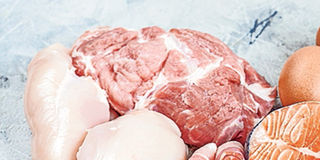How Covid-19 crisis has boosted safety of meat products

Different types of meat. Preventive measures (biosecurity) go a long way in ensuring the safety of beef products. PHOTO | FILE | NATION MEDIA GROUP
What you need to know:
- While protecting himself and others from Covid-19 by keeping away from crowds, he has also protected his animals from other infectious diseases that would compromise on the safety of beef.
- Licenced meat transporters usually ensure that the beef is delivered to various retail outlets. It is important to note that beef, just like many other foods of animal origin such as milk, mutton, pork, has a short shelf life.
- Because of the timelines for the delivery of meat – for example adherence to food grade materials for transporting meat and how far it can be transported – all defined laws should continue even after the pandemic.
- Simple actions like regular hand-washing and sanitising that were often overlooked previously have indeed become a norm courtesy of Covid-19.
Joe, a pastoralist beef farmer, has traditionally walked his three-year-old Sahiwals to the nearest animal market for sale. This has been his main economic activity for many years.
Occasionally, some animals presented to the market fail to get a buyer, which sees him walk them back home, a distance of more than 10 kilometres. This is after exposing them to all sorts of infections and fatigue stress.
However, lately due to Covid-19, the farmer only sells his cows on order directly from his farm. Additionally, he has installed a disinfectant footbath at his gate for all traders visiting to purchase his cattle.
While protecting himself and others from Covid-19 by keeping away from crowds, he has also protected his animals from other infectious diseases that would compromise on the safety of beef.
By not walking his animals for long distances, he has improved the quality and ultimately safety of beef from his Sahiwals.
Such preventive measures (biosecurity) have gone a long way in ensuring the safety of the beef products derived from his animals.
Other measures that he has instituted include proper animal nutrition, which results in enhanced immunity and, therefore, reduced antibiotic use and residues.
In so doing, his Sahiwals will be healthy and will consequently provide safe and better-quality beef.
At the local abattoir where Joe’s Sahiwals are slaughtered, operations are significantly different. The chaotic scenes that usually characterised the abattoir are a thing of the past.
No more crowding, only a few flayers and butchers are allowed in and handwashing and sanitising is now the modus operandi.
The animal market near the abattoir is non-operational and, therefore, there is no more hawking.
By adhering to a strict set of rules and directives, the butchers and flayers have not only reduced the risk of contracting Covid-19 but also chances of contaminating beef and by-products with other food-borne infectious agents, thus ensuring meat safety.
SHORT SHELF-LIFE
Licenced meat transporters usually ensure that the beef is delivered to various retail outlets. It is important to note that beef, just like many other foods of animal origin such as milk, mutton, pork, has a short shelf life.
As transporters keep to designated working timelines and geographical boundaries due to Covid-19 regulations, they are indeed also helping in delivery of fresh food to the consumers, thus ensuring safety of those foods.
Because of the timelines for the delivery of meat – for example adherence to food grade materials for transporting meat and how far it can be transported – all defined laws should continue even after the pandemic.
Simple actions like regular hand-washing and sanitising that were often overlooked previously have indeed become a norm courtesy of Covid-19.
Retail outlets like butcheries and supermarkets where Joe’s animal products end up are now a lot more conscious of meat handling hygiene, meaning a lot of consumers could be protected from food-borne infections, which usually occur due to unhygienic handling.
Other value chains, for example, that of milk, will also benefit from hygienic handling at the point of dispensing. This is more so in informal markets where hygiene has been a challenge.
Considering that the safety of products such as meat, milk, mutton and so on, is a factor of cumulative controls along the value chain from the farm (producer) to the fork (consumer), it is imperative that hazards of whatever nature must be prevented at all costs, with or without a pandemic.
The farmer should ensure that his animals are healthy by adhering to good management practices such as vaccinations, observing biosecurity measures, engaging registered animal health professionals for extension and clinical services as well as providing proper nutrition.
Movement of animals should only be done after certification by government authorities that they are free from diseases.
Processors and other players in the animal value chains should ensure that they operate within the requisite laws to safeguard the safety of the consumer.
This is more so because the popular adage, ‘health is wealth’, cannot be over emphasised during and after the Covid-19 pandemic.
Dr Nyaga is a registered veterinarian while Mr Nyang’ori works at MESPT — AgriFI Food Safety Programme




